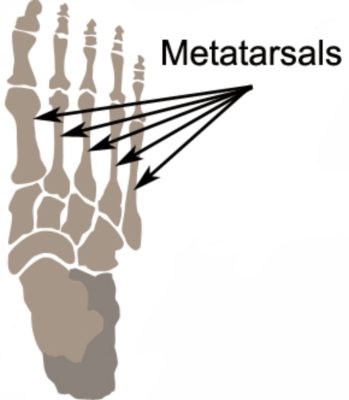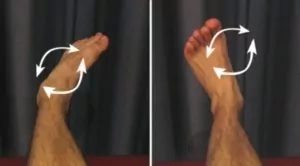Metatarsal Stress Fracture
Updated:
(Also known as Stress Fracture of the Metatarsal)
What is a metatarsal stress fracture?
A metatarsal stress fracture is a condition characterized by an incomplete crack in one of the metatarsal bones. There are five metatarsal bones each of which is located in the forefoot (figure 1).

Weight bearing activity (such as running) places load through the metatarsal bones. Furthermore, several muscles attach to the metatarsals. When these muscles contract, a pulling force is exerted on the respective bones.
When these forces are excessive or too repetitive and beyond what the bone can withstand, bony damage can gradually occur. This initially results in a bony stress reaction, however, with continued damage may progress to a metatarsal stress fracture. Of the metatarsals, the second metatarsal (next to the big toe) is most commonly affected.
Cause of a metatarsal stress fracture
A stress fracture of the metatarsal typically occurs over time with excessive weight bearing activity such as running, sprinting, jumping or dancing. They often occur following a recent increase in activity or change in training conditions (such as surface, footwear or technique changes etc). Occasionally this condition may occur traumatically such as landing onto a hard surface from a height.
Signs and symptoms of a metatarsal stress fracture
Patients with this condition typically experience pain in the forefoot that increases with impact activity (such as running, jumping, dancing or standing on toes) and may decrease with rest. Symptoms may also radiate to other areas of the foot that are not specifically involved in the injury. Occasionally, patients may notice swelling or discolouration at the stress fracture site.
In more severe cases, standing or walking may be enough to aggravate symptoms (often causing the patient to limp) and patients may experience pain with rest. Other symptoms may include night ache, pain on squeezing the forefoot or pain on firmly touching the affected metatarsal bone.
Diagnosis of a metatarsal stress fracture
A thorough subjective and objective examination from a physiotherapist may be sufficient to diagnose a metatarsal stress fracture. Further investigations such as an X-ray, MRI, CT scan or bone scan are usually required to confirm diagnosis and determine the severity of injury.
Prognosis of a metatarsal stress fracture
With appropriate physiotherapy management, most patients with this condition can make a full recovery (return to sport or full activities) in a period of 3 – 9 months. In more severe cases, recovery may take 1 year, or longer, depending on the intervention required and a range of other factors. In rare cases (usually those that have been poorly managed), some patients may experience ongoing symptoms or complications which may require further management.
Treatment for a metatarsal stress fracture

Members Only ContentBecome a PhysioAdvisor Member to gain full access to this exclusive content. For more details see Become a Member. Already a member? Login Now
Contributing factors to the development of a metatarsal stress fracture
There are several factors which may contribute to the development of this condition. These need to be assessed and corrected with direction from the treating physiotherapist. Some of these factors include:
- inappropriate or excessive training (particularly on hard or uneven surfaces)
- poor foot posture (especially flat feet or high arches)
- poor biomechanics
- muscle weakness (particularly of the gluteals, quadriceps, calf and core stabilisers)
- poor balance
- poor flexibility (particularly of the calf muscles)
- ankle joint stiffness
- inappropriate footwear (especially high heels or tight shoes)
- poor running technique
- inadequate diet
- leg length discrepancies
- being overweight
- menstrual disturbances
Physiotherapy for a metatarsal stress fracture
Physiotherapy treatment for patients with this condition is vital in to hasten healing, prevent injury recurrence and ensure an optimal outcome. Treatment may comprise:
- soft tissue massage
- joint mobilization
- electrotherapy (e.g. ultrasound)
- dry needling
- the use of crutches
- the use of a protective boot or brace
- activity modification advice
- foot taping
- biomechanical correction (e.g. the use of orthotics or a metatarsal raise)
- technique correction
- footwear advice
- exercises to improve strength, balance and flexibility
- education
- a gradual return to running / activity plan
Other intervention for a metatarsal stress fracture
Despite appropriate physiotherapy management, some patients with this condition do not improve and require other intervention to ensure an optimal outcome. The treating physiotherapist or doctor can advise on the best course of management when this is the case. This may include further investigations such as X-rays, CT scan, MRI or bone scan, extended periods of non weight bearing immobilization, the use of a protective boot, review with a podiatrist for possible orthotics or referral to appropriate medical authorities who can advise on any intervention that may be appropriate to improve the metatarsal stress fracture. Occasionally, patients with this condition may require surgery to stabilize the stress fracture and aid healing.
Exercises for a metatarsal stress fracture
The following exercises are commonly prescribed to patients with this condition. You should discuss the suitability of these exercises with your physiotherapist prior to beginning them. Generally, they should be performed 3 times daily and only provided they do not cause or increase symptoms.
Your physiotherapist can advise when it is appropriate to begin the initial exercises and eventually progress to the intermediate and advanced exercises. As a general rule, addition of exercises or progression to more advanced exercises should take place provided there is no increase in symptoms
Initial Exercises
Foot and ankle up and down
Move your foot and ankle up and down as far as possible and comfortable without pain (figure 2). Repeat 10 – 20 times provided there is no increase in symptoms.

Foot and ankle in and out
Move your foot and ankle in and out as far as possible and comfortable without pain (figure 3). Repeat 10 – 20 times provided there is no increase in symptoms.

Foot and Ankle Circles
Move your foot and ankle in a circle as large as possible and comfortable without pain (figure 4). Repeat 10 – 20 times in both clockwise and anticlockwise directions provided there is no increase in symptoms.

Intermediate Exercises

Members Only ContentBecome a PhysioAdvisor Member to gain full access to this exclusive content. For more details see Become a Member. Already a member? Login Now
Advanced Exercises

Members Only ContentBecome a PhysioAdvisor Member to gain full access to this exclusive content. For more details see Become a Member. Already a member? Login Now
Rehabilitation Protocol for a Metatarsal Stress Fracture

Members Only ContentBecome a PhysioAdvisor Member to gain full access to this exclusive content. For more details see Become a Member. Already a member? Login Now
 Find a Physio
Find a Physio
Find a physiotherapist in your local area who can treat a stress fracture of the metatarsal.
 Physiotherapy products for a metatarsal stress fracture
Physiotherapy products for a metatarsal stress fracture
Some commonly recommended products by physiotherapists for patients with this condition include:
-
 Talar Made TRIO Orthotics (3/4 length)
Talar Made TRIO Orthotics (3/4 length) -
 AllCare Ortho Total Ankle Brace (AOA19)
AllCare Ortho Total Ankle Brace (AOA19) -
 Forearm Crutches Adjustable – Standard Grip
Forearm Crutches Adjustable – Standard Grip -
 AllCare Wobble Board (Red – ACWOBRD)
AllCare Wobble Board (Red – ACWOBRD) -
 AllCare Band
AllCare Band -
 Premium Strapping Tape 38mm (Victor)
Premium Strapping Tape 38mm (Victor) -
 AllCare Tubing
AllCare Tubing -
 Fixomull Stretch 5cm x 10m
Fixomull Stretch 5cm x 10m -
 Lournet Stability Dura Disc
Lournet Stability Dura Disc -
 AllCare Ortho Standard Walker (Cam Boot)
AllCare Ortho Standard Walker (Cam Boot) -
 Thermoskin Heat Retaining Ankle Wrap
Thermoskin Heat Retaining Ankle Wrap
To purchase physiotherapy products for a metatarsal stress fracture click on one of the above links or visit the PhysioAdvisor Shop.
 Other Exercises
Other Exercises
 More Useful Information
More Useful Information
- Correct Footwear .
- How to Use Crutches
- Do I Need Orthotics?
- Return to Running Program.
- Ice or Heat.
- Why is My Injury not Improving?
- Foot Diagnosis Guide.
Become a PhysioAdvisor Member
-
 Individual Membership (12 Months)$59.95 for 1 year
Individual Membership (12 Months)$59.95 for 1 year -
 Individual Membership (3 Months)$39.95 for 3 months
Individual Membership (3 Months)$39.95 for 3 months -
 Individual Membership (Yearly)$49.95 / year
Individual Membership (Yearly)$49.95 / year -
 Individual Membership (Monthly)$15.95 / month
Individual Membership (Monthly)$15.95 / month

Link to this Page
If you would like to link to this article on your website, simply copy the code below and add it to your page:
<a href="https://physioadvisor.com.au/injuries/foot/metatarsal-stress-fracture”>Metatarsal Stress Fracture – PhysioAdvisor.com</a><br/>PhysioAdvisor offers detailed physiotherapy information on a metatarsal stress fracture including signs & symptoms, diagnosis, causes, treatment, exercises, rehabilitation protocol, physiotherapy products and more...
Return to the top of Metatarsal Stress Fracture.
